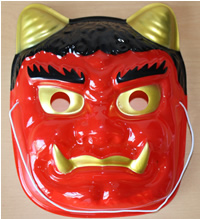by Jeff Myers

Japan's bean-throwing ritual called Setsubun (節分) occurs on the lunar calendar's last day before spring (February 3) and is celebrated at temples, shrines and homes with a bean-throwing event called mame maki (豆撒き). At temples and shrines, actors, athletes, mascots as well as other celebrities and honorees attend the festival. As a means to cleanse the past and bring good fortune for the new year, they throw roasted soy beans nicknamed fortune beans (福豆 [fuku mame]) from elevated stages while shouting, "Devil out!" (鬼は外 [oni wa soto]). "Good fortune in!" (福は内 [fuku wa uchi]). Meanwhile, attendees extend their hands, purses, shopping bags, even their hats, trying to catch just a few beans for fun.
Most families don't attend the bean-throwing festival, but instead gather at home for the ritual. The father will usually open the front door of the home and throw the fortune beans outside, shouting "Devil out!" He then slams the door shut and tosses more beans onto the inside floor, softly requesting "Good fortune in!"
In another version of the ritual, the father will stand outside the home, portraying evil by wearing a plastic devil mask (鬼のお面 [oni no omen]) while his children target him with fortune beans, shouting "Devil out!"

Families often throw a conservative amount of fortune beans both outside and inside their homes compared to the festival because they don't want to be burdened with picking up dozens of scattered beans. They will also save enough beans to be eaten after the ritual. Each family member will eat the number of beans that corresponds to their age, plus one more for the forthcoming year. For elderly people in their 70s or 80s, they may just eat 7 or 8 beans.
Fortune beans are sold at supermarkets and convenience stores between the middle of January and the first few days of February and typically cost about ¥150 (US$1.65) for a small package. Devil masks are commonly packaged along with the beans and sold as a set for a higher cost.
Images and Text © 2013 by Pangea's Tribe
Introduction to Japanese | Hiragana | Katakana | Kanji | Rōmaji | Phrases (Useful) | Phrases (Silly) | Numbers | Colours | Time | Dates | Family words | Tower of Babel | Articles | Links | Learning materials
Writing systems | Language and languages | Language learning | Pronunciation | Learning vocabulary | Language acquisition | Motivation and reasons to learn languages | Arabic | Basque | Celtic languages | Chinese | English | Esperanto | French | German | Greek | Hebrew | Indonesian | Italian | Japanese | Korean | Latin | Portuguese | Russian | Sign Languages | Spanish | Swedish | Other languages | Minority and endangered languages | Constructed languages (conlangs) | Reviews of language courses and books | Language learning apps | Teaching languages | Languages and careers | Being and becoming bilingual | Language and culture | Language development and disorders | Translation and interpreting | Multilingual websites, databases and coding | History | Travel | Food | Other topics | Spoof articles | How to submit an article
[top]
You can support this site by Buying Me A Coffee, and if you like what you see on this page, you can use the buttons below to share it with people you know.

If you like this site and find it useful, you can support it by making a donation via PayPal or Patreon, or by contributing in other ways. Omniglot is how I make my living.
Note: all links on this site to Amazon.com, Amazon.co.uk
and Amazon.fr
are affiliate links. This means I earn a commission if you click on any of them and buy something. So by clicking on these links you can help to support this site.
[top]